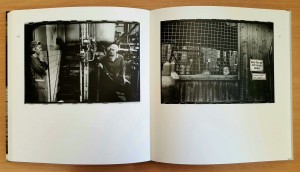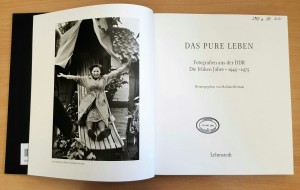
One of the probably less known areas which we collect is photography in the GDR. Cambridge University Library thus has a substantial collection on the topic. One publisher is particularly active in that field, called Lehmstedt Verlag, and we have a substantial number of their publications on the topic. However, there is of course a variety of publishers from which we acquire such material. Our collections include various academic books about the topic that can be borrowed, although a lot of the material we acquire is heavily illustrated and/or an exhibition catalogue and therefore cannot be taken out of the building. A few of those books recently caught my attention as they crossed my desk:

Based on an exhibition held from the 24th of September until the 15th of Novemer 2015 in Berlin, we recently received the book Barbara Köppe : das (de)konstruierte Glück : Fotografien DDR 1964-1990, edited by Ursula Röper (S950.c.201.665). It was published by Nicolai in 2015. Born in 1942 in Magdeburg, Köppe trained to become a professional photographer and settled in Berlin with her family. She is described as neither a feminist nor a political revolutionary, but also never joined the SED and adopted a critical attitude towards political propaganda. The lives of women in the GDR were one of the main subjects of her works, and her photographs don’t shy away from depicting rough working and living conditions. She spent most of the 1960s working for the Neue Berliner Illustrierte (an East-German magazine) before she quit in 1968 as she felt the gap between the ideological stories that she was supposed to work on and the reality had become too wide. She started working as a freelance photographer, something that wasn’t politically desirable, and remained freelance until the end of the GDR. Many of the photographs shown at the exhibition last year and printed in this book have never been published before.

In 2014, Lehmstedt Verlag published the two volume set Das pure Leben : Fotografien aus der DDR, edited by Mathias Bertram (S950.a.201.3131-3132). The first volume focuses on the early years of the GDR and covers the years 1945-1975. Accordingly, the second volume covers the late years from 1975-1990. The volumes include pictures from 60 different photographers and focus, much like the pictures of Barbara Köppe, on a realistic rather than propagandistic depiction of everyday life and work in the GDR. Due to their realism, and mirroring Köppe’s experience, most of the pictures featured in Das pure Leben were never printed in official GDR publications, even though the photographers themselves often worked for them in some capacity.
The exhibition catalogue Geschlossene Gesellschaft : Künstlerische Fotografie in der DDR 1949-1989 = The shuttered society : art photography in the GDR 1949-1989 (S950.b.201.2929), published by Kerber in 2012, takes a comparable approach by giving a broad overview of artistic photography in the GDR. It is based on an exhibition held at the Berlinische Galerie in Berlin held from the 4th October 2012 until the 28th of January 2013. The selection presented originates from a collection of GDR photography gathered by Ulrich Domröse in the 1980s when he was working on a research project for the Association of Visual Artists in East Berlin. In addition to a selection of photographs, the exhibition catalogue also includes short biographies for all artists as well as several academic essays, all of which have also been translated into English and are included in the appendix of the publication.

For his book on GDR posters, David Heather on the other hand did the exact opposite by looking specifically at East German propaganda. His book DDR Poster : Ostdeutsche Propagandakunst : the art of East German propaganda (S950.a.201.2353), published by Prestel in 2014, includes prints of 122 posters published between 1945 and 1989. They have been selected out of over 9000 posters held in the Deutsche Historische Museum (DHM, the German Historical Museum) in Berlin. The selection tries to shed some light onto how the state tried to influence its people through propaganda and how those attempts evolved over time. The book is divided into categories for each decade, all of which are preceded by a brief introduction. It also includes an introductory essay. All of the text is presented in both German and English.
In addition to the very heavily illustrated publications mentioned above, Cambridge University Library has various further books on the subject, including the following:
- Fotografie zwischen Politik und Bild : Entwicklungen der Fotografie in der DDR / Sabine Schmid (C210.c.7464)
- Die DDR im Bild : Zum Gebrauch der Fotografie im anderen deutschen Staat / herausgegeben von Karin Hartewig und Alf Lüdtke (571:78.c.200.36)
- Greif zur Kamera, Kumpel! : Die Geschichte der Betriebsfotogruppen in der DDR / Regine Schiermeyer (C210.c.7651)
Stephanie Palek

